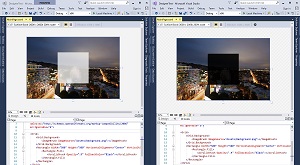News
Microsoft Addresses Angst About Visual Studio XAML Designer with Update
Microsoft last week admitted that while it added new features to the Visual Studio XAML Designer over the years, the tool lost some of its allure among developers, who spoke up about dragging performance and asked for improvements.
"Why is this still pending after almost 6 years?!?!?!?" reads one UserVoice comment from June about a slow-performance issue that was first raised in August 2011. "This thing wears down my computer, please fix this."
That developer was among some 1,850 others who voted for XAML Designer improvements -- developers who likely had become all too familiar with clicking on a XAML page and realizing too late they forgot to specifiy "view code," putting themselves in for a long wait as the graphical tool fired up ... if it ever did.
"It often takes several seconds for a XAML Window to fully display," the original UserVoice issue said. "The editor is constantly pausing as I type, sometimes for as long as a second, before catching up with keystrokes."
Last week, the Visual Studio blog announced "a significant update to the XAML Designer" that addressed these concerns.
"The XAML designers in Visual Studio and Blend have been powerful tools for developers and designers alike to build beautiful user experiences for Windows applications," the blog post said. "Initially designed for WPF development in 2007, we have made significant changes to support a wide variety of XAML platforms over the last decade. We’ve also added new features along the way to increase developer productivity. Unfortunately, with all these changes, the performance and reliability of the designer have become less than ideal. We’ve heard the community loud and clear and we are working hard to fix that."
The improvements, still in early preview, features major achitectural changes made to address design considerations, performance, fidelity (concerning the new Fluent UI design system), reliability and more.
Microsoft admitted that the early preview -- rushed out the door to get early developer feedback in the ongoing transformation -- doesn't yet support many features, such as animation tooling, a text edit tool, several kinds of commands (ordering, alignment, group into, combine, path and so on) and more.
 [Click on image for larger view.] Demonstrating Increased Fidelity for the AcrylicBrush Resource (Preview Experience Shown in Left Graphic) (source: Microsoft).
[Click on image for larger view.] Demonstrating Increased Fidelity for the AcrylicBrush Resource (Preview Experience Shown in Left Graphic) (source: Microsoft).
"In order to get customer input as early as possible, we had to make some hard engineering decisions," Microsoft's Daniel Jacobsen said in the post. "With that in mind, we are aware of several issues with the new XAML Designer that are called out in the release notes" for Visual Studio 2017 version 15.4.0 preview.
Addressing reader comments, Jacobsen revealed that the improved XAML Designer will be rolled out to the more mature WPF platform only after the team is certain it works well enough -- updates will first be introduced to the UWP Designer to ensure current setups aren't destabilized with the changes.
The team will continue work on the project to reimplement the most-requested tools, Jacobsen said, while emphasizing design considerations.
"When we have confidence that the designer provides more productivity than the existing designer and does not break any existing workflows, we will deliver these benefits by default for an increasing number of XAML scenarios," he said.
"In addition, we will be collaborating with top designer extension developers as we reimplement the XAML designer extensibility model in support of their goals.
"We look forward to building the best XAML designer for developers by engaging with the community early and heavily prioritizing our investments around their feedback."
The revamped XAML Designer can be tried out with the latest Visual Studio 2017 Preview.
About the Author
David Ramel is an editor and writer at Converge 360.